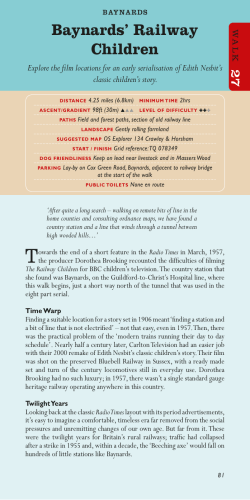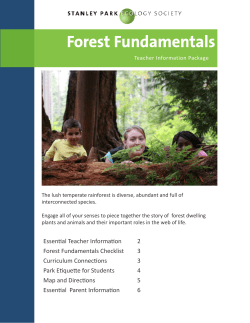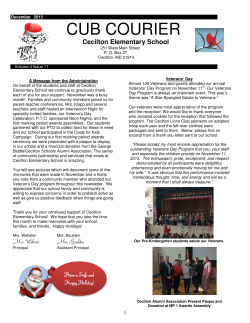
The Railway Children Teacher’s notes LEVEL 2
Teacher’s notes PENGUIN READERS Teacher Support Programme LEVEL 2 The Railway Children Edith Nesbit community. The famous writer H.G. Wells, who was a family friend, said that their house was ‘a place to which one rushed down from town at the weekend to snatch one’s bed before anyone else got it’. Nesbit wore her hair cut short, dressed in a very modern way, smoked cigarettes in public and always said exactly what was on her mind. When her husband died in 1914, Nesbit was heartbroken, and her financial situation once again became unstable. Her difficulties were eased a little in 1915, when she was awarded a small pension from the government for her services to literature. She also sold produce from the garden of her house to bring in a little extra money. About the author Like Roberta, Peter and Phyllis in The Railway Children, Edith Nesbit (1858–1924) was born into a middle-class family whose fortunes eventually declined. Unlike the children in the novel, however, Nesbit didn’t see her problems suddenly swept away. Her financial troubles continued throughout her lifetime – even until her death. Nesbit’s childhood was a difficult one. Her father died when she was only four years old, and her mother moved the family around Europe looking for a warm, dry climate suitable for Nesbit’s sister, Mary, who suffered from consumption, a disease that was incurable at the time. It wasn’t until 1871 – after Mary’s death – that the family settled in south-east England in Kent. One of Kent’s main attractions was the railway line that ran past a field at the back of the family’s house. Living in this house, Nesbit began writing poetry – some of which was eventually published – and started dreaming of becoming a great poet. Later, Nesbit moved to London, where she met and married Hubert Bland in 1880. She was seven months pregnant when they were married, which went very much against the conventions of the day. Her husband’s business collapsed, and it wasn’t long before Nesbit had to provide the main source of income for their growing family. She achieved this mainly by writing poetry, stories, novels – anything that matched the literary taste of the time. Slowly, the family’s fortunes improved. Bland became a successful journalist, and Nesbit focused her energies on writing children’s stories, which brought her fame and success. Nesbit and her husband had a very lively social life, and their house was always full of guests from the art c Pearson Education Limited 2008 In 1917, Nesbit married a cheerful marine engineer named Thomas Terry Tucker. After struggling on her own for three years, Nesbit found her marriage to Tucker to be an enormous relief. Her final novel, The Lark, which was published in 1922, represented a return to form for Nesbit. Unfortunately, however, she didn’t have a chance to keep the form going, as she died two years later from the ill effects of lung cancer. Summary First published in 1906, The Railway Children is one of Edith Nesbit’s most famous children’s novels. Like many of her other stories, it is recognised by many experts as one of the greatest classics of the genre. At the beginning of The Railway Children, the reader is introduced to three siblings, Roberta, Peter and Phyllis, who come from a fairly wealthy family. Their lives are stable and happy until one day their father is mysteriously taken away from them. Their mother refuses to say where their father has gone – only that he is ‘not coming back for a long time’. Without the father’s income, the mother and the children have to move to smaller lodgings in the country. The children quickly become fascinated with the railway line that runs past the bottom of the garden behind their flat, and they make friends with the drivers and the guards who work at the railway station. However, they are now so poor that they can no longer afford to buy coal for the fire or nutritional food to eat. The disappearance of their father hangs over them like a dark cloud. In the end, Roberta, Peter and Phyllis manage to find out what has happened to their father, and they learn something else at the same time – the difference between right and wrong in their own lives. The Railway Children - Teacher’s notes of 3 Teacher’s notes PENGUIN READERS Teacher Support Programme LEVEL 2 The Railway Children Background and themes Before the nineteenth century, few stories were written specifically for children, and the few that were indeed focused on the non-adult market had the considerably less-than-enjoyable goals of teaching children how to behave properly and developing their moral values. In order to enjoy fiction, children had to read books meant for adults, such as Robinson Crusoe and Gulliver’s Travels. However, in the early part of the nineteenth century, children’s literature became more prominent, as publishing and distribution costs began to fall. By the second half of the nineteenth century, many different types of children’s books were being written. Most of the stories were largely set in fantasy worlds, which were considered to be the ideal locations for the imaginations of children. For example, at this time, Victorian author Lewis Carroll (1832–1898) wrote the much-loved Alice’s Adventures in Wonderland (1865), which wasn’t concerned with real-world settings. Nesbit, on the other hand, wrote adventures about children in the world that they shared with adults. In this way, she was able to mark out her own territory in the genre of children’s fiction. The characters in The Railway Children are true to life, and they are portrayed in such a way that young readers find it easy to identify with them and sympathise with their emotions. Although Nesbit introduced elements of magic and fantasy into some of her stories, her children are psychologically real, and the situations they have to cope with are equally genuine. For this reason, Nesbit has been called ‘the first modern writer for children’. Discussion activities Chapters 1–2 Before reading 1 Discuss: Ask students to look at the picture on the cover of the book. What can you see? Where do you think the story takes place? Who do you think the story is about? What do you think happens in the story? 2 Discuss: Ask students if they have ever seen a film version of The Railway Children. Did you like the film? Why or why not? Do you remember any of the characters in the story? List the characters the students mention on the board, and then ask them to find pictures of the characters in the book. c Pearson Education Limited 2008 3 Pair work: Put students into pairs and get them to ask each other the following questions about travelling: How often do you travel? Where do you usually travel to? What is your favourite way to travel – by aeroplane, bus, car, ship or train? Why do you feel this way? What is your least favourite way to travel? Why do you feel this way? After reading 4 Artwork: Have students draw a picture of a train engine. When they have finished, they should show their pictures to the rest of the class. 5 Read carefully: Get students to read page 1 and find sentences to show that the children are happy before their father goes away. They should write down the sentences on a piece of paper. When they have finished, they should share the sentences they found with the rest of the class. Chapters 3–4 Before reading 6 Write: Ask students to read the children’s letter on page 10. Tell them to pretend that they are the man on the train and get them to write a short letter to reply to the children’s letter. Point out to them that they should sign the letter ‘Mr Smith’. 7 Discuss: Look at the picture on page 11. What do you think the man on the train is doing? Why do you think he is doing it? After reading 8 Write: Ask students to look at the picture of the man on the train on page 11. Then get them to write sentences to answer the following questions: What does the man look like? How old is he? Is he rich or poor? Where does he live? What kind of job does he have? Is he friendly or mean? 9 Role play: Divide the class into groups of five and get them to role play the scene in Chapter 4. 10 Artwork: Get students to draw a picture to describe what happens in Chapter 4. When they have finished, they should show their pictures to the rest of the class. Chapters 5–6 Before reading 11 Pair work: Put students into pairs and ask them to look at the heading on page 14. Get them to discuss why the chapter is named ‘Fire! Fire!’ 12 Discuss: Have students look at the picture on page 17. What is happening in the picture? What is wrong with the boat? What are the children doing? Why are they doing it? What do you think will happen to the children? The Railway Children - Teacher’s notes of 3 Teacher’s notes PENGUIN READERS Teacher Support Programme LEVEL 2 The Railway Children After reading After reading 13 Role play: Divide the class into groups of four. One student is Roberta, one student is Peter, one student is Phyllis and one student is a person living in the village. Roberta, Peter and Phyllis should ask the villager if he or she wants to give something to Perks for his birthday. The villager should answer ‘yes’ or ‘no’, and then give the children at least one reason for his or her answer. 14 Discuss: Get students to look at the picture on page 19 and discuss the following questions: Who is the woman? What does she look like? What is she doing? Why is she doing it? How is she feeling? 19 Discuss: Have students look at the picture on page 32. How do you think Roberta is feeling? How do you know this? How do you think Roberta’s father is feeling? How do you know this? 20 Write: Point out to students that Roberta, Peter and Phyllis study at home instead of going to school. Get them to write a paragraph to support or oppose studying at home. You can start the exercise by asking them the following questions: Do you think studying at home is a good or bad idea? Why do you feel this way? Would you like your parents to teach you at home? Why or why not? Do you know anyone who studies at home? Does he or she like it? Why or why not? Chapters 7– 8 Before reading Vocabulary activities 15 Pair work: Teach the word spy to students. Then put them into pairs and get them to ask each other the following questions: What is a spy? What do spies do? Why do they do it? Do spies have exciting or boring jobs? Is being a spy dangerous? Would you like to be a spy? Why or why not? 16 Discuss: Look at the picture on page 23. Who is the spy? What happened to him? Why did it happen? For the Word List and vocabulary activities, go to www.penguinreaders.com. After reading 17 Research: Ask students to bring information about spies to class. Put a large piece of paper on the wall and then get students to attach their information to the piece of paper to make a wall display. Chapters 9 –10 Before reading 18 Guess: Get students to predict what will happen at the end of the story. Will the man on the train help the children? Will the children’s father return? Will the children be happy again? c Pearson Education Limited 2008 The Railway Children - Teacher’s notes of 3
© Copyright 2026














